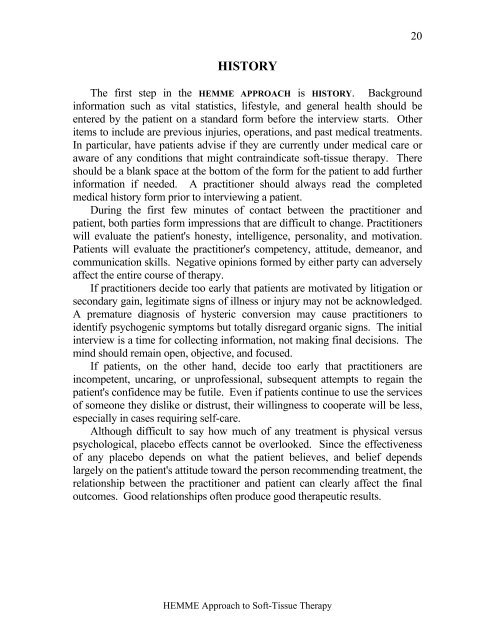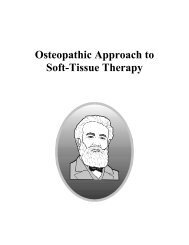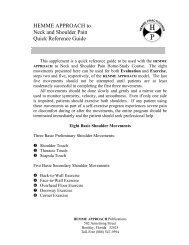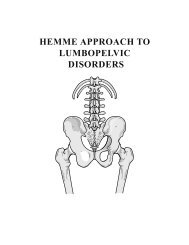HEMME APPROACH TO SOFT-TISSUE THERAPY
HEMME APPROACH TO SOFT-TISSUE THERAPY
HEMME APPROACH TO SOFT-TISSUE THERAPY
You also want an ePaper? Increase the reach of your titles
YUMPU automatically turns print PDFs into web optimized ePapers that Google loves.
20<br />
HIS<strong>TO</strong>RY<br />
The first step in the <strong>HEMME</strong> <strong>APPROACH</strong> is HIS<strong>TO</strong>RY. Background<br />
information such as vital statistics, lifestyle, and general health should be<br />
entered by the patient on a standard form before the interview starts. Other<br />
items to include are previous injuries, operations, and past medical treatments.<br />
In particular, have patients advise if they are currently under medical care or<br />
aware of any conditions that might contraindicate soft-tissue therapy. There<br />
should be a blank space at the bottom of the form for the patient to add further<br />
information if needed. A practitioner should always read the completed<br />
medical history form prior to interviewing a patient.<br />
During the first few minutes of contact between the practitioner and<br />
patient, both parties form impressions that are difficult to change. Practitioners<br />
will evaluate the patient's honesty, intelligence, personality, and motivation.<br />
Patients will evaluate the practitioner's competency, attitude, demeanor, and<br />
communication skills. Negative opinions formed by either party can adversely<br />
affect the entire course of therapy.<br />
If practitioners decide too early that patients are motivated by litigation or<br />
secondary gain, legitimate signs of illness or injury may not be acknowledged.<br />
A premature diagnosis of hysteric conversion may cause practitioners to<br />
identify psychogenic symptoms but totally disregard organic signs. The initial<br />
interview is a time for collecting information, not making final decisions. The<br />
mind should remain open, objective, and focused.<br />
If patients, on the other hand, decide too early that practitioners are<br />
incompetent, uncaring, or unprofessional, subsequent attempts to regain the<br />
patient's confidence may be futile. Even if patients continue to use the services<br />
of someone they dislike or distrust, their willingness to cooperate will be less,<br />
especially in cases requiring self-care.<br />
Although difficult to say how much of any treatment is physical versus<br />
psychological, placebo effects cannot be overlooked. Since the effectiveness<br />
of any placebo depends on what the patient believes, and belief depends<br />
largely on the patient's attitude toward the person recommending treatment, the<br />
relationship between the practitioner and patient can clearly affect the final<br />
outcomes. Good relationships often produce good therapeutic results.<br />
<strong>HEMME</strong> Approach to Soft-Tissue Therapy









